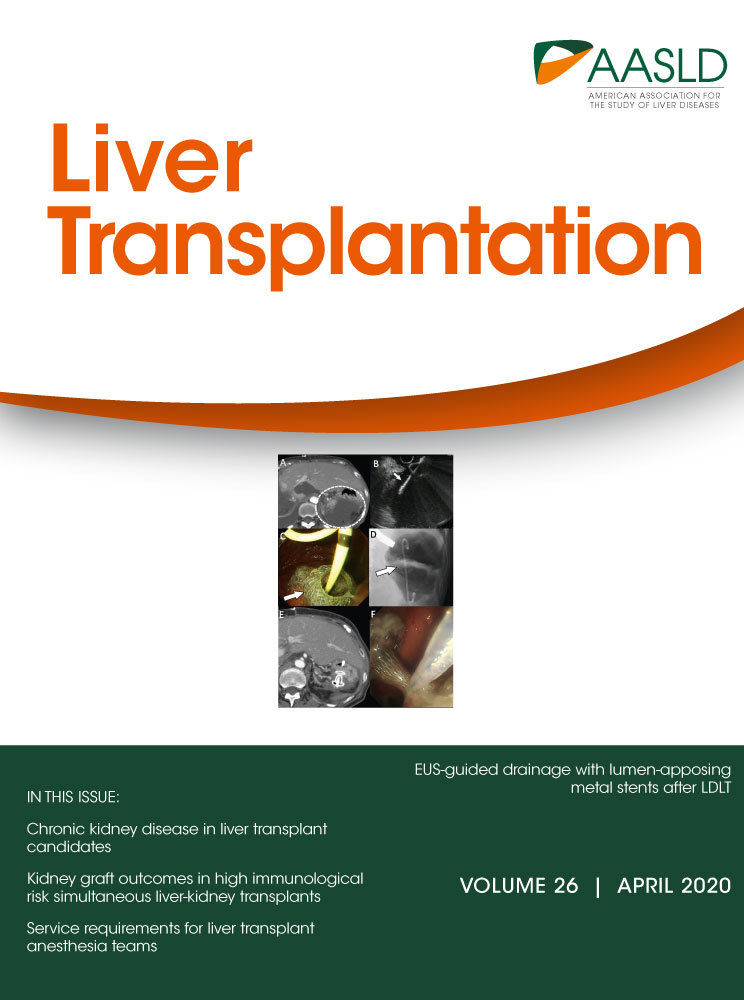Liver Transplantation in Adults With Wilson’s Disease for the Neuropsychiatric Phenotype: Are We There Yet?
Abbreviations
-
- ACLF
-
- acute-on-chronic liver failure
-
- ALF
-
- acute liver failure
-
- LT
-
- liver transplantation
-
- WD
-
- Wilson’s disease
Wilson’s disease (WD), or hepatolenticular degeneration, is an autosomal-recessive disorder of copper metabolism, characterized by copper accumulation in the liver and in many extrahepatic organs especially the eyes and brain.1 It is caused by mutations in the ATP7B gene, which encodes a transmembrane copper ATPase that excretes copper into bile for synthesis of ceruloplasmin, a major copper-transporting protein in the blood. This defect results in hepatic copper overload and oxidative damage of hepatocytes, which in turn leads to copper being released into circulation and its accumulation in extrahepatic organs.1, 2 Hepatic manifestations range from asymptomatic hepatomegaly or transaminitis to decompensated cirrhosis and acute liver failure (ALF). Neuropsychiatric manifestations include movement disorders, seizures, depression, behavioral abnormalities, and psychosis. Early diagnosis and treatment with chelating agents and/or zinc prevents morbidity and mortality associated with WD.1, 2 Advanced hepatic and neurological disease and lack of adherence to chelation therapy predict poor survival.
Liver transplantation (LT) is indicated for patients with ALF and for chronic liver disease unresponsive to medical therapy, which corrects the genetic defect restoring copper homeostasis.1, 2 Because ALF is associated with poor transplant-free survival, especially in patients with high modified WD index (score of ≥11), patients are listed on urgent basis with status 1A.1 However, data on the beneficial role of LT for the neuropsychiatric phenotype of WD are inconsistent. In fact, paradoxical deterioration of unclear mechanisms has been described after LT for WD.1-4
In this issue, Ferrarese et al. provide retrospective observational data (2006-2016) on LT in 27 Italian patients with WD (17 with the isolated hepatic phenotype, 2 with the isolated neuropsychiatric phenotype, and 8 with the mixed phenotype).5 With a median follow-up of 6 years, overall 1- and 5-year patient survivals were 88% and 83%, respectively.5 These observations are consistent with other reports of 79%-88% and 75%-86%, respectively.6, 7 LT outcomes are reported to be better for decompensated cirrhosis compared with ALF.6 The comparison of ALF with decompensated chronic liver disease was not possible because only 1 patient fulfilled the criteria for ALF. The rarity of true ALF in patients with the advanced hepatic phenotype of WD has also been reported previously.7 For example, of 50 WD patients in 1 study receiving LT for presumed ALF, only 3 explants had an absence of underlying chronic liver disease or cirrhosis.7 It appears that the majority of these patients have acute-on-chronic liver failure (ACLF), as noted in this study with 14 (56%) patients having ACLF at the time of LT. Compared with decompensated cirrhosis, patients transplanted for ACLF had higher Model for End-Stage Liver Disease score (30.5 versus 21), longer intensive care unit stay (7 versus 4 days), and a higher frequency of posttransplant complications, as observed in other reports on LT for ACLF.8, 9 However, the patient survival rates were similar, including 2 patients with failure of 3 or more organs (ACLF grade 3). Younger age, shorter wait-list time, and not being on ventilator explained the good outcomes of 2 patients in this study as compared with the experience of ACLF grade 3 in other studies.8, 9
Of the 10 patients with neuropsychiatric features (6 with severe neurological and 4 with severe psychiatric manifestations), posttransplant patient survival was similar to the hepatic phenotype.5 However, LT recipients for the mixed hepatic and neuropsychiatric phenotype experienced more frequent complications (75% versus 59%), especially due to infections. LT also did not provide a benefit in improving the neuropsychiatric symptoms or signs. The authors used the validated Unified Wilson’s Disease Rating Scale to examine the response on neuropsychiatric features.5 Of the 2 patients receiving LT for the isolated neuropsychiatric phenotype, the posttransplant course of a female patient with severe ataxia, dystonia, and tremor was notable for prolonged hospitalization with multiple complications. In the second case, a bedbound male patient with severe dystonia and tremor had only modest improvement in neurological symptoms. These data are consistent with other reports on the lack of benefit of LT on neuropsychiatric features.5 Some studies have also reported paradoxical neurological deterioration after LT for WD with neuropsychiatric manifestations.3, 4 The authors of the study suggest that the lack of improvement of neuropsychiatric symptoms could be due to insufficient follow-up after LT.5
In the current study, WD accounted for 0.4% of all LTs in Italy,5 a frequency lower than that reported by others.6, 7 For example, in 2 other European studies, WD was implicated in 1.0%-1.2% of all LTs.3, 7 In another United Network for Organ Sharing–based study, WD accounted for 0.63% of all LTs in the United States.6 The current report included only adults receiving LT for WD in contrast to other studies that also included children. It should be noted that the current WD cohort included only patients with severe disease with a WD index of ≥11, whereas other studies also included moderate cases.6, 7
Despite its retrospective nature, the current study illustrates the rarity of ALF and the more frequent occurrence of ACLF among patients with WD. It also confirms the excellent posttransplant outcomes for the hepatic presentation of WD. The data were somewhat inconclusive on the benefit of LT for neuropsychiatric WD. Clearly, larger prospective multicenter studies with at least 6-12 months of follow-up are needed to examine the role of LT and the criteria of selection for patients with the neuropsychiatric phenotype of WD.




